More of nature’s bounty from the garden
As mentioned in Part One, flowers simply never go out of fashion. Here are a dozen more artists who have found ways to put a fresh spin on a centuries-old subject.
Peggy Klineman: “Living in New York City, I longed to be in nature, and the community garden in my neighborhood was a place where I often found solace. There was the most magnificent magnolia tree that bloomed every spring in Hell’s Kitchen—it was a welcome signal to everyone in the ‘hood that spring was finally here. As a colorist who was part of the urban jungle, I found that using a gray scale to depict the splendid tree served my mood and the environment best.”
Teresa Cox: “My artwork references the tradition of object and landscape painting through a transcendent abstract language. Based on ephemera, textiles, and sensations experienced in nature, the paintings explore metaphor and relationships that occur when familiar subjects (flowers, trees, vases) are flattened, fragmented or exaggerated to create new associations.
“To further exploit and enliven the paintings’ surrealistic nature, I accentuate with poured paint forms, robust colors, and metallic and patterned papers. This work re-interprets nature and its most intimate details into a broad sweep of otherworldly environments and offers a conversation around a felt landscape and a contemplative bridge between ourselves and the natural world.”
Chelsea Gibson: “This was the first painting I made in my new studio, which my husband and I built at our home in upstate New York. The work commemorates a recent miscarriage. I never make paintings about situations or stories, but this one had some intention behind it. That’s why it’s called Flowers for a Secret. I haven’t spoken about my loss with many people, as it is a very private, sad event that many women go through silently. My work is so much about what life is like in the country, especially the domestic parts that make a home a home, and there was no ignoring what a huge impact the loss had on my life and my work. So to have this painting out in the world—it was at Lyons Wier Gallery in Chelsea through August 30—and to know that it might make people happy, thinking of beautiful summer days in a sunny country kitchen, is just wonderful, and provides a huge sense of relief. Because the work continues to evolve and live, and I’m okay too.”
Claudine Metrick: “I began this work when we moved away from our first house. I spent seven years there, cultivating a space filled with native plants in the hopes of making our yard more ecologically beneficial. The paintings began as a way to memorialize the garden and the work that went into it. While working on this series, I became interested purely in the forms and colors of plants. I have since moved from painting to building imagined botanical landscapes through a process of drawing and collage.”
David Leaser: “My passion is creating highly detailed botanical photographic images which show viewers a side of nature they have never seen before. To do that, I have used a technique that involves “focus stacking”—multiple images, all taken with a different focal point, then layered together to create a detailed composite, in focus from front to back.
“My journey toward developing my botanical art began in the depths of the Amazon, where I was shooting landscapes but found myself captivated by the tiniest of living things on the rain-forest floor. Early macro photography equipment, namely lenses, could only capture a small depth of field, which is not what I wanted. I wanted to create imagery that rivaled art, where the entire image is in focus.
“After experimenting with other technologies and software, I became intrigued by the Nikon D850, which makes it easy for any photographer to achieve these results natively in the camera. I recently tested the camera on rare and exotic plants at the Huntington Library, Art Collections and Botanical Gardens outside Los Angeles. I particularly wanted to see how the D850 would capture and display details. For me, the results were nothing short of spectacular.”
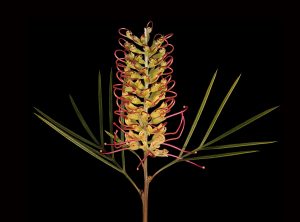
Grevillea, dye sublimation print on polished aluminum, 50 by 40 inches (Native to Australia, where Aborigines shake the nectar into their hands, but do not drink directly from the flower because many contain cyanide)
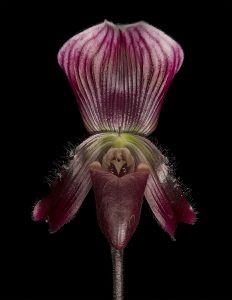
Paphiopedilum callosum, dye sublimation print on polished aluminum, 50 by 40 inches. (A rare, endangered slipper orchid from Vietnam)
Pat Conway: “Spring came racing in, and the cactus by my studio suddenly had many dark bumps that burst into pods and pads faster than I could catch up The neighbor’s tree began its bloom all in one area, providing an interesting contrast of line and form. The dark season passed too.
“I want my work to be spontaneous, a little off center, unbalanced, lively, attenuated, thoughtful, and to have a backstory.”
Leslie Parke: “Although I obviously paint nature, it is often about the ‘space between,’ what you look at when you are not looking at anything; it is the air not the tree; the light not the landscape; the background not the subject. A painting succeeds for me when it seems as though the light is emanating from the canvas.”
Christine Sauer: “My abstract, intuitive paintings celebrate the beauty, strangeness, and transitory quality of nature. Invented forms, unusual colors, and energized mark-making coalesce to suggest flora and the vitality of growth and the life cycle. I don’t usually start with a plan for these paintings, but as they develop they often suggest an alternative reality of imagined natural processes and the organic soup of life.”
Nina Meledandri: “I work with flower imagery quite a bit, most recently in an ongoing series called “Harmonic Convergence.” These are flowers in various stages of their life cycle photographed on top of paintings (both oils and watercolors), resulting in an inkjet print.”
Sherri Silverman: “Flowers growing, flowing, hinting about something beyond this physical beauty. Floating images and dots or circles appear, as they do in my pastels, sometimes indicating vibrant plant life energy radiating onto the picture plane. These dots and circles suggest subtle levels of energy and creation manifesting into physical form. Gouache, oil, Sumi ink, pastels, and mixed media paintings. The series title comes from one of my 1970s poems, inspired by meditation experiences of flowers appearing in my inner vision. Who is creating the flowers? Who is seeing them?”
Susan Schwalb: “In the 1970s, I began working in silverpoint and metalpoint drawing, and my first series was “Orchids and Other Flowers.” I drew exclusively from dried flowers. I have always loved orchids and remembered as a young person the thrill in receiving one from a date. A friend was working in a florists’ shop and I would often stop by to say hello. There was this beautiful orchid in a refrigerated case, and when no one bought it, she gave it to me. When it dried, I began to draw and the series took off. There are almost 200 drawings in this group, and many are quite sexy and sensuous. O’Keeffe was a natural model for me, as was the feminist art movement that I was part of.
Barbara Kemp Cowlin: “’Bloom’ is a series of paintings in which I imbue flowers with personality. I’ve always loved flowers and have been drawn to painting them—as I paint I inevitably think about my mother, who was an avid gardener. I’m not after accuracy, but in capturing the quirky character of the flowers. The backgrounds are partially made up of stencils I create echoing the characteristic shapes of groups of flowers. The borders are made at the same time as the paintings. On the Cusp is a painting of spent sunflowers which were still hanging on when the first frost of fall fell. Pomp & Circumstance is a bouquet I happened upon at the Phoenix Art Museum which was left over from a wedding there—depicting the hopes but also the extravagance in modern-day weddings. Let’s hope the marriage lasts longer than the flowers.
Top: Leslie Parke, Breakfast in Bed (2005), oil on linen, 30 by 40 inches

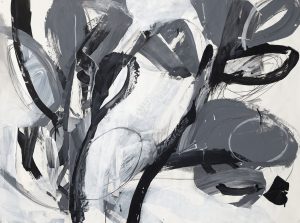
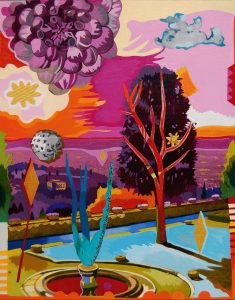
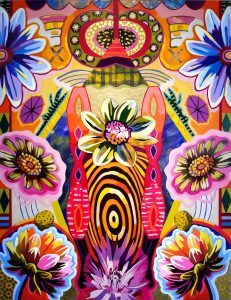
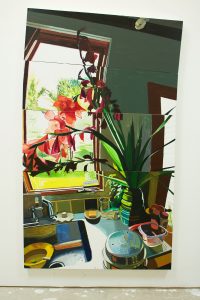
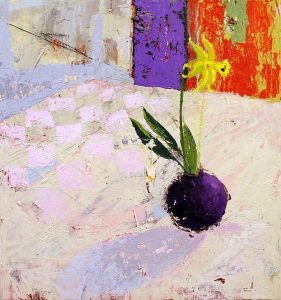
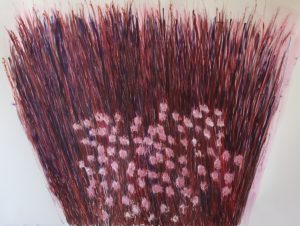
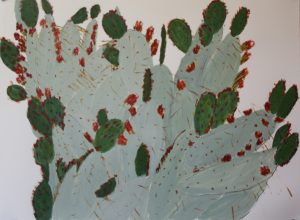
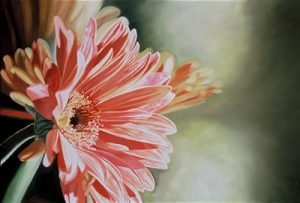
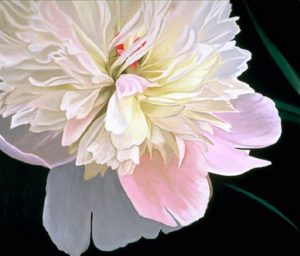
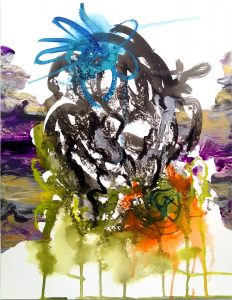
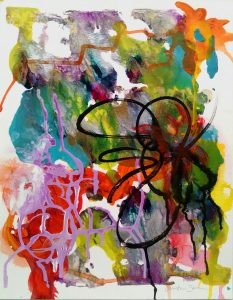
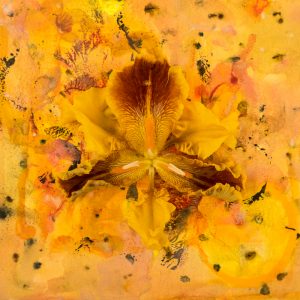
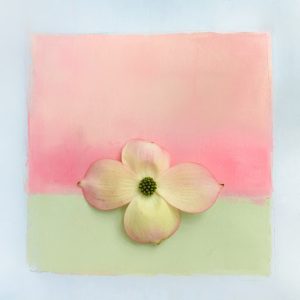
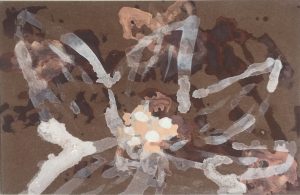
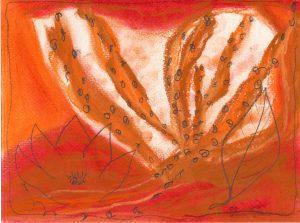
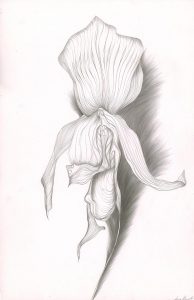
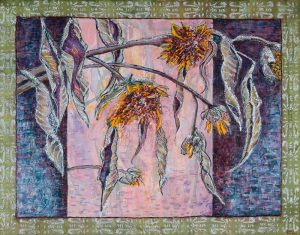
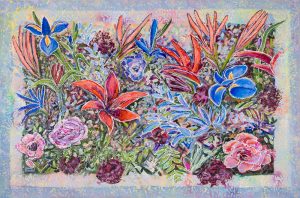
I so enjoyed seeing all of the wonderful work and varied approaches to this subject matter. Thanks Ann for including my work. 🙂
Thanks Ann .
Thanks for including my flower paintings in this article. It’s amazing to see the variations in the way artists express the subject, in both Part One & Part Two. It’s nice to get encouragement for painting beauty when the art world focuses so much energy on the grimmer side of life.
such beauty & poetry, thanks for including me.
So beautiful.